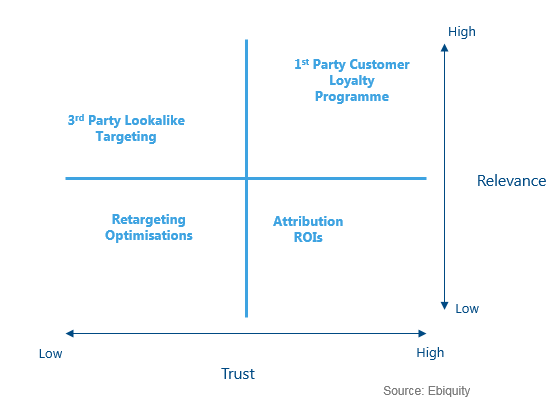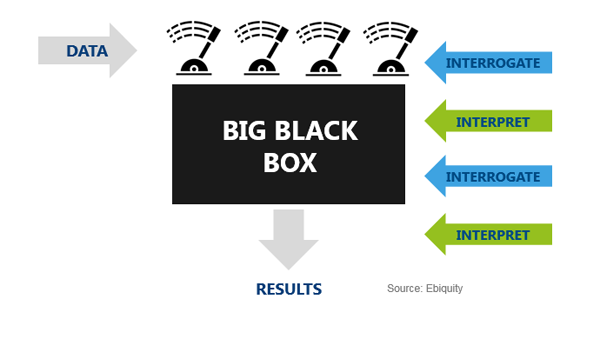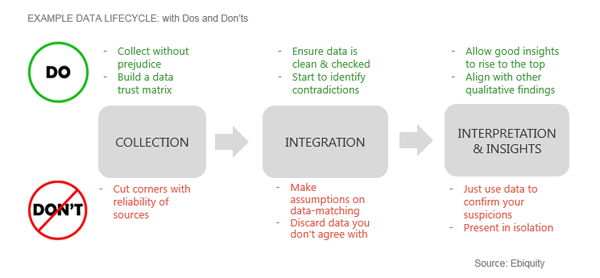Now that the industry is getting to grips with building storage and manipulation capabilities to cope with the huge volume of data, attention will turn to making data work harder for us. Perhaps 2018 will be the year of ‘Data Effectiveness’, says Verity Gill of Ebiquity.
Let’s be clear, the management of data is a challenge. But like any unruly and perhaps unfamiliar beast, management is always part of a larger strategy and in the case of data this comes down to three areas of focus; trust, over-dependency and misuse. Looking at this, one could say that building a data strategy is a little like building a new relationship, apologies for the analogy but as you will see below it is surprisingly fitting…
1. Data Trust
Wherever your data has come from, treat it with caution. You may have heard good things about it, you may have built it yourself, but when it comes to data you can never be too careful. This is especially true from May 2018 with the introduction of the new European General Data Protection Regulation. Not only will the validity and accuracy of third party data be important factors in its reliability, but also the compliance and governance of those who collect and process the data, with expensive consequences for those not adhering to the rulebook.
Introduce new data sets with caution and create a scoring framework that works for your business. For example, we would suggest building a Data Authenticity Matrix in which you can use whatever data attributes you like, as long as you have a ‘Trust’ Axis (see Diagram 1). You can build a number of these matrices, but just make sure you have taken the time to plot your data sources and have given them an associated score so that if, or more likely when, you have contradicting results you can work on the facts rather than unconscious bias that you may be tempted to fall back on. When your competitors have similar access to data that you have, what will stand your insights apart from those of others is the quality of your data. If you start strong by putting these rules in place, you have a solid foundation to build on, you are also able to cross-reference more efficiently.
Diagram 1: Data Authenticity Matrix

2. Over-dependency on one solution
There is a real temptation to try and integrate all data sources together, for one single solution, for example through a DMP. Although in theory this is a great idea, there are a number of watch-outs to be aware of. Be careful that when you are merging data sets you don’t lose any critical detail. From your data matrices you will have a priority of data sources, so bear this in mind when you are trying to create a data infrastructure. When placing everything into one solution framework, ensure that this system gives you transparency and never loosen your grip on the origination of the data sources.
Diagram 2: Constantly question the black box

Your data infrastructure is critical to your business, but structure does not mean organising data into a neat box that you will never have to open again. Try not to think about data as a problem that has to be fixed, think of it more as a room that needs to be tidied – a place for everything and everything in its place. This will ensure that you know where everything is when you want to find it, and if get a new piece of furniture that complements that room, you will know just where to put it – even if it means moving a few things around.
3. Misuse of data
This point represents the dark-side of data. There are so many stages of the data lifecycle that can corrupted leading to data being used in the wrong way, for the exact opposite reason that we should be using it. Data should be used in the generation of good insights, but with total neutrality. The more data we have, the more likely we are to find data that can be used to support our own personal theories. Big data has changed the entire insight ecosystem, but it should not rock the solid foundation of good research and analysis. Big data does introduce challenges in terms of integration and infrastructure, but it should not fundamentally change the methodologies that have been traditionally used to relate inputs to outputs. Logic is now more important than ever, and in the panic to use (or misuse) as much data as possible to outsmart the competition, marketers can put themselves in danger of overusing data in chaotic and unstructured ways just to make a point. However by the time the data stars have aligned, sometimes it is difficult to remember what that point was in the first place.
Diagram 3: How to use, not misuse data

Approach data with an open mind, building a web of data distortion will only lead to one thing and that is failure to isolate good insights. The truth behind data will always come out and therefore you are only delaying the inevitable.
Checklist:
- Create a Data Authenticity Matrix, and keep it up to date
- Always retain transparency around your data sources and integrations
- Build insights around data in a neutral space

